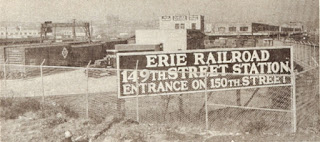That said, most of us that studied Harlem Station came to take a face value the big Erie's billboard at 148th Street/Exterior Street's corner: "Entrance on 150th Street".
 |
| Erie Railroad Magazine - February 1952 issue |
That small sentence made us all believe the ONLY access to Harlem Station ground was on 150th Street. But today, after close examination of landscape around the station, I came to change my understanding. Unfortunately, as stated before, I can't publish those pictures and wish to respect the kind gentleman that was generous enough to give me access to invaluable data. However, a few pictures from Trainweb.org will help to set my discoveries.
Here are a few things I always thought didn't make sense. First, there is a concrete pad on the pier near the carfloat. This concrete pad isn't connected to any other road, circulation and concrete pad on the property, making this area unreachable to vehicle. In fact, I always wondered why such a concrete pad was there and thought both isolated sidings where only car storage.
 |
| Track Planning for Realistic Operation, Second edition, by John Armstrong, Kalmback Publishing |
But this started to change when I discovered the siding perpendicular to Harlem River along 149th Street was in fact used by a coal dealer. Looking at pictures, a truck coming from 150th Street entrance would have to cross a maze of turnouts to reach its destination. The funny thing is that you won't see any evidence of a road or a trail.
Looking at a few pictures, I found out the concrete pad by the river was raising slightly toward the south. In fact, the concrete pad is raising because the small street north to 149th Street Bridge embankment is higher than Harlem Station grounds (about 6 feet sloping gently toward the river).
The answer lies in the next picture:
 |
| J. Long photo, D. Biernacki Collection, J. Held Archives |
I have access to high resolution version of this photograph. On the upper left, you can see a hopper spotted on the siding perpendicular to Harlem River. At the hopper's right, the coal dealer shed is clearly visible. But upon closer inspection, at the hopper's right you can see an overhead structure on the fence. That structure is a common type chainlink gate.
Thus, the riddle is solved. If Harlem Station main entrance was effectively located on 150th Street, there was a secondary entrance located east to 148th street near the river. This gate gave access to a coal dealer but it could have been more. The concrete pad is well-known to have reached as far as the carfloat apron, thus servicing the siding parallel to it. Does it means this short curved siding where we often see cars spotted was in fact another tenant? I'm seriously think it was.
May I say I'm quite happy to have include about 1 inch on the perimeter of the layout to model a glimpse of surrounding topography. Now, I have a very nice detail to model and that will add more operation interest.
As a certain famous fiction character would have said about the recent Pluto Flyby: Fascinating!
And just for fun, here are some progress pictures of the layout. Today's historical discoveries were directly fuelled by my need to make a correctly shaped fascia in that area.




No comments:
Post a Comment